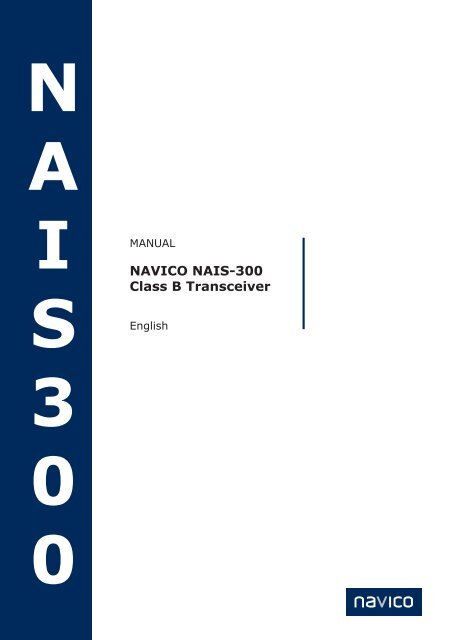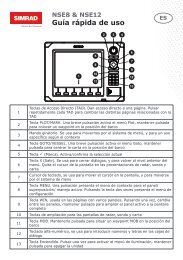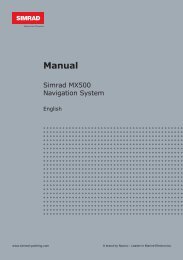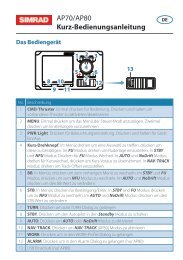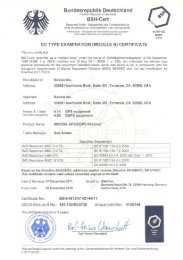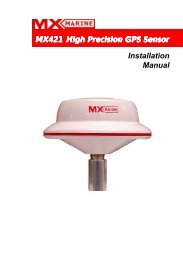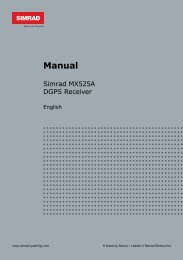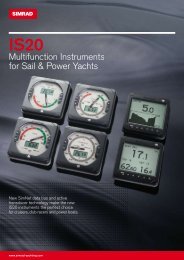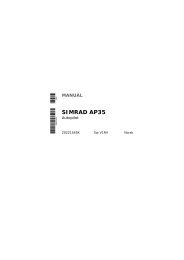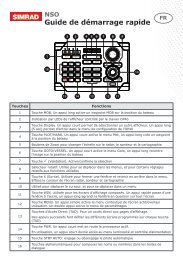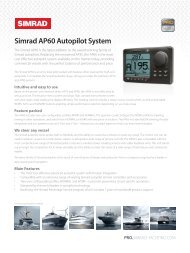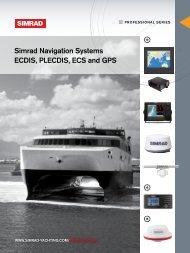NAIS 300 User Manual
NAIS 300 User Manual
NAIS 300 User Manual
- No tags were found...
Create successful ePaper yourself
Turn your PDF publications into a flip-book with our unique Google optimized e-Paper software.
2 Installation2.1 GeneralThe <strong>NAIS</strong>-<strong>300</strong> is designed to be mounted on a flat surfacesomewhere out of sight, but easily accessible. However,to determine the best possible location, you need toconsider how and where, you are going to run the cablingfrom the sides of the unit.The <strong>NAIS</strong>-<strong>300</strong> is very simple to install, however, theperformance of the equipment is directly affected by thequality of the installation. Please read these instructionscarefully before attempting installation. If in any doubt,consult a qualified marine electronics engineer.2.2 MountingThe transceiver requires a flat surface with a minimumarea of at least 210mm x 130mm (8.3in x 5.1in) formounting, with an overall area of 210mm x 250mm (8.6inx 9.8in) to allow for cables.The surface should be rigid and sturdy enough to be ableto support the weight of the unit, taking into account theshock loads likely to be encountered when the vessel isunder way in heavy seas.123Hold the unit against the surface where it is to bemounted, and mark the position of the four holeswith a pencil.Drill a 3.7mm (.145in) hole on each corner mark.Align the holes on the <strong>NAIS</strong>-<strong>300</strong> with those youhave just drilled, and fasten with the 4 - No.8 x 3/4self tapping screws supplied.Installation
2.3 CablingOnce you have secured your <strong>NAIS</strong>-<strong>300</strong> to a flat surface,you will need to connect the power, SimNet/NMEA2000and RS232 cables supplied with the unit. The RS485 cableand switch are not supplied, but would be fitted in thesame manner.PowerNMEA0183-HS(RS485)⎧⎨⎩⎧⎨⎩+12vdc0v.Out +veOut -veIn +veIn -veNMEA0183-HS(RS232)⎧⎨⎩Out -veGnd.In +ve⎧External Switch ⎨⎩Switch +Switch -Figure 2.1 - Connector wiringWith reference to the connector wiring, Figure 2.1 and theassembly diagram, Figure. 2.2, wire your unit as follows:ClampRetaining ScrewsSimNet/NMEA2000Socket SplashCoverNipplesPowerConnectorGrommetSimNet/NMEA2000ConnectorNMEA0183-2 & SwitchConnector<strong>NAIS</strong>-<strong>300</strong> CaseFigure 2.2 - <strong>NAIS</strong>-<strong>300</strong> assembly Installation
NMEA2000 (<strong>300</strong>-L model only)With the supplied cable connected to the <strong>NAIS</strong>-<strong>300</strong>,connect the other end into the supplied T-connector, thenconnect this into the vessels NMEA2000 network.2.5 NMEA0183-HS (RS232 supplied)This data cable is used to connect the <strong>NAIS</strong>-<strong>300</strong> to a PCor laptop in order to configure it, and for AIS enabled PCchartplotter applications. For further information regardingthe wiring of this cable please refer to chapter 3.22.6 NMEA0183-HS (RS485 not supplied)This data cable is used for connectivity to AIS enabledchart plotters and other marine equipment with anNMEA0183-HS interface. For wiring information, refer toFigure 2.1.(NMEA0183-HS is specified at 38.4kbaud and is notcompatible with conventional NMEA0183, which operatesat the lower speed of 4800baud)2.7 Transmit disable switch (not supplied)Any momentary action, push to make switch can be used.Take a wire from each terminal of the switch and wirethem into the connector. Refer to figure 2.1. Becausethere is negligible current drawn through this cable, anysuitable two core cable will do, providing it forms a goodseal once inserted in the grommet. Refer to section 4.3.2.8 GPS antennaThe antenna, ideally needs to be mounted as lowas possible with a clear view of the sky to minimiseerrors due to movement over and above the transitorymovement of the vessel.The GPS antenna is capable of being flush mounted ona suitable flat area of the cabin roof or deck area. Inthis configuration, fit the supplied rubber gasket underthe antenna and use the four threaded studs, nuts andwashers to fix the antenna down.10 Installation
The cable can be routed in the molding to drop downdirectly underneath, or by breaking out the thin traps, thecable can be routed out of the side of the antenna.Alternatively, the antenna may be fixed on a standard 1”threaded mounting pole (Not supplied). Attach the suppliedmounting base to the antenna with the four screws, threadthe cable down the center hole and through the pole.Thread the pole into the mounting base, before attachingthe pole to the superstructure.To minimize interference, place the antenna in a positionaway from steel constructions, wires, metal masts, sourcesof electrical interference, such as radar etc. If installingthe GPS antenna close to other antennas, mount it eitherabove or below their radiation beams.<strong>NAIS</strong>-<strong>300</strong>The antenna cable is terminated in a screw fit connector(SMA). Push the antenna plug into the socket on the sideof the unit and screw down the retaining collar.GPS AntennaRx Tx BIIT PWRVHF Antenna73.5mm2.9inFigure. 2.3 - Antenna connections210mm (8.27in)2.9 VHF antenna (not supplied)North American <strong>User</strong>s - To meet FCC (FederalCommunications Commission) rules on Radio FrequencyExposure, it is recommended that the VHF antennais mounted at least 3m (10ft) away from any areaaccessible to any personnel on board. If this distance isachieved by vertical separation, the antenna must be atleast 5m (16.5ft) above deck. This guideline applies onlyto antennas not exceeding 3dBi gain.Failure to observe these recommendations mayexpose those within the MPE (Maximum PermittedExposure) radius of 1m (3ft) to RF absorption levelsthat exceed the FCC safe limits.Installation 11
The most important factor in the performance of anyAIS transceiver will be the quality and positioning of theantenna.As the range of VHF signals are governed by line of sight,the antenna should be placed as high as possible, whileremaining clear of any metallic objects.Long whip antennas are generally recommended forlarger boats, although the most popular antennas formarine use is 1m (3ft 3in) long. On sailboats these areusually mounted on the masthead, where the length ofthe antenna keeps it clear from the navigation lights andwind vanes. This type of antenna can also be mounted onthe cockpit roof or powerboat garages.For maximum range, it is recommended that a VHF antennaspecifically tuned for use with an AIS is used, and mountedaway from the standard VHF antenna. Vertical separation ispreferred, but where this is not practical, at least 5 metrehorizontal spacing is recommendedThe antenna coaxial cable and any connectors usedmust be rated at 50Ω. Under no circumstancesshould standard domestic TV cable and connectorsbe used. Incorrectly rated cabling and connectorscould result in power not reaching the antenna, butalso power could be reflected back into the <strong>NAIS</strong>-<strong>300</strong> unit, reducing its performance.The quality of any connections and integrity of thecable will directly affect the performance of the radio.Poor soldering or corrosion of the terminals can impairperformance. We recommend that screw or crimpterminal type connectors are not used for any throughdeck fittings - a good quality waterproof solder terminalconnector will be less susceptible to poor connection dueto corrosion of the contacts.To ensure the best performance of the radio, the antennacable should be routed where it is least likely to interferewith, or receive interference from other electronicequipment, such as echo sounder transducer cables andhigh current carrying cables.12 Installation
14 Installation
3 Configuration3.1 GeneralBefore the <strong>NAIS</strong>-<strong>300</strong> can become fully functional, it willbe necessary to load the following information about yourvessel into the unit:•••••Vessels NameCall SignMMSI NumberVessels DimensionsVessel TypeIn order to enter this information, you will need toconnect your <strong>NAIS</strong>-<strong>300</strong> to your PC or laptop through thesupplied RS232 cable. This can be done in the comfort ofyour living room at home.3.2 Connecting to a computerWire one end of the supplied RS232 cable into the connectorblock on the main unit, refer to Fig 2.1, then plug the 9 pinRS232 connector into the serial port on your PC or laptop.If your PC or laptop does not have a serial port, and youare using a USB to serial converter, please ensure this isfully installed before proceeding.12345Insert the Installation CD into your computer andlocate the “Setup.exe” file.Double click the “Setup.exe” file to begin installation.Follow the on screen prompts to install the .Netframework, if required.When a security warning is displayed, Press “Install”.A Start Menu folder and shortcut will be created withthe name “proAIS“. This shortcut should be used tore-launch the application as required.Configuration 15
For security reasons the MMSI of the vessel cannotbe changed once programmed. Do not programmethe MMSI unless you are certain you have thecorrect information. Please check the numberentered carefully. If the MMSI programmed isincorrect the AIS transponder will need to bereturned to the supplier for factory reset.Should it become necessary to change your MMSI, forexample, if you wish to re-install your <strong>NAIS</strong>-<strong>300</strong> into anew vessel; you will need to contact your local Navicodealer about reprogramming a new number.If no MMSI is entered the AIS transponder will operate inreceive only mode. The vessels own position will not betransmitted. An MMSI must be entered to allow the AIStransponder to transmit its own position to other vessels.For a more detailed description of how to configure your<strong>NAIS</strong>-<strong>300</strong>, please refer to the application user guide on theCD supplied with the unit.16 Configuration
4 Operation4.1 GeneralThe <strong>NAIS</strong>-<strong>300</strong> has a limited user interface, consisting ofa transmit enable/disable switch, (not supplied), and fourindicators on the top of the unit, they are:••••PWR [Green] - Power/GPS Lock Status/Silent ModeBIIT [Red] - Built In Integrity TestTX [Yellow] - TransmitRX [Blue] -AIS Message Received4.2 IndicatorsAt power up, all four LED’s will light continuously for fiveseconds to show that they are working, then they will gointo the following routines:PWRAfter the initial five seconds the LED will do two shortflashes and a longer pause before repeating itself. Thiswill continue until a GPS position fix is acquired. Once afix has been obtained, the LED will stay on continuously.If, after a GPS fix, the transmitter has been disabled,(Silent Mode), the LED will flash at a rate of one secondon and one second off.BIIT (Built In Integrity Test)The <strong>NAIS</strong>-<strong>300</strong> is constantly monitoring and testing theintegrity of the AIS transceiver.After the initial five seconds the LED will go out. Should afault be detected within the unit, the “BIIT” LED will startto flash. The flash sequences listed below indicate thespecific faults:1 flash - transponder not reponding2 flashes - transmitter fault3 flashes - receiver fault4 flashes - VHF antenna VSWR fault5 flashes - no GPS sensorOperation 17
6 flashes - noise threshold exceeded7 flashes - voltage supply faultThe “BIIT” message will remain there until the fault iscleared by the <strong>NAIS</strong>-<strong>300</strong> circuitry, or the unit has beenrepaired.TXAfter the initial five seconds the LED will then go out. Itwill light for one second every time the unit transmits itsAIS data.The LED will also light continuously if a transmitter time-outfault occurs.RXAfter the initial five seconds the LED will flash every timean AIS message is received.4.3 Enable/disable switch (Silent Mode)This switch allows you to turn the <strong>NAIS</strong>-<strong>300</strong>’s VHFtransmitter “on” or “off”, rendering you either visible orinvisible to other AIS equipped vessels in your VHF range.The default mode is with the transmitter active, “on“.To turn your transmitter off push the switch once.The “PWR” LED on the top of the unit will start to flash ata rate of one second on and one second off. The “TX” LEDwill remain off.To turn your transmitter back on simply push the switchagain.This mode will be stored in the <strong>NAIS</strong> memory, thereforewhatever mode you are in when power is turned off, willbe the same when power is restored.18 Operation
5 Appendix5.1 MaintenancePeriodically check that the cables are secure and that theconnectors have not worked their way loose.5.2 TroubleshootingThese simple checks should be carried out before seekingtechnical assistance and may save time and expense.General Symptom Possible Cause RemedyUnit will not switch onNo GPS Position fixNo AIS transmissionNo reception ofNMEA0183-HSNo reception ofSimNet/NMEA2000data• Faulty connector to power• Fuse has blown• Check powerconnection• Replace fuse and checkpower supply• Antenna or cable problem • Check antenna cableand connections• MMSI not entered• Transmit disabled• RS232 cable problem• RS485 cable problem• Enter MMSI number(see chapter 3)• Enable Transmit (seesection 4.3)• Check cables• SimNet/NMEA cable• Check SimNet/NMEAproblemcables• Check power cables5.3 AccessoriesThe following accessories are available from local Navicoagents:VA14*VHF AIS antenna - S/S whip with 20 metresCable, terminated in a PL259 plug.* One off required for operationAppendix 19
5.4 Product specificationsAIS TypeClass B for use on non-SOLAS craftVHF ReceiverReceiver typeSensitivityTransmit powerType Approval MeetsGPS ReceiverReceiver typeEMCIEC60945PowerVoltageDual TDMA (shared DSC)< -107dBm for 20% PER2WattIEC62287-1Integral 16 channel receiver10.8 – 15.6VDCCurrent
NMEA2000 AIS PGNs129038 Class A Position Report129039 AClass B Position Report129040 Class B Extended Position Report129792 DGNSS Broadcast Binary Message129793 UTC and Date Report129794 Class A Static and Voyage Related Data129795 Addressed Binary Message129796 Acknowledge129797 Binary Broadcast Message129798 SAR Aircraft Position Report129800 UTC/Date Enquiry129801 Addressed Safety Message129802 Broadcast Safety Message129803 Interrogation129804 Assignment Mode Command129805 Data Link Management MessageAppendix 21
5.5 DimensionsRx Tx BIIT PWR<strong>NAIS</strong>-<strong>300</strong>73.5mm2.9in210mm (8.27in)167.5mm (6.6in)Figure 5.1 - <strong>NAIS</strong>-<strong>300</strong> dimensionsFigure 5.2 - GPS Antenna dimensions5.6 Service and warrantyIf it is necessary to have a unit repaired, please contactyour local authorized dealer. For worldwide warrantydetails and a list of authorised Navico agents please referto the Warranty Card supplied with this unit.22 Appendix
EnglishFinnishDutchFrenchSwedishDanishGermanGreekItalianSpanish5.7 Declaration of Conformity (EU)Hereby, Navico AS declares that this <strong>NAIS</strong>-<strong>300</strong> is in compliance with theessential requirements and other relevant provisions of Directive 1999/5/EC.Navico AS vakuuttaa täten että <strong>NAIS</strong>-<strong>300</strong> tyyppinen laite on direktiivin1999/5/EY oleellisten vaatimusten ja sitä koskevien direktiivin muiden ehtojenmukainen.Hierbij verklaart Navico AS dat het toestel <strong>NAIS</strong>-<strong>300</strong> in overeenstemming ismet de essentiële eisen en de andere relevante bepalingen van richtlijn 1999/5/EG.Par la présente, Navico AS déclare que ce <strong>NAIS</strong>-<strong>300</strong> est conforme aux exigencesessentielles et aux autres dispositions de la directive 1999/5/CE qui lui sontapplicables.Härmed intygar Navico AS att denna <strong>NAIS</strong>-<strong>300</strong> står i överensstämmelse medde väsentliga egenskapskrav och övriga relevanta bestämmelser som framgår avdirektiv 1999/5/EG.Undertegnede Navico AS erklærer herved, at følgende udstyr <strong>NAIS</strong>-<strong>300</strong>overholder de væsentlige krav og øvrige relevante krav i direktiv 1999/5/EF.Hiermit erklärt Navico AS, dass sich dieses <strong>NAIS</strong>-<strong>300</strong> in Übereinstimmung mitden grundlegenden Anforderungen und den anderen relevanten Vorschriften derRichtlinie 1999/5/EG befindet. (BMWi)µε την παρουσα Navico AS δηλωνει οτι <strong>NAIS</strong>-<strong>300</strong> συµµορφωνεται προςτις ουσιωδεις απαιτησεις και τις λοιπες σχετικες διαταξεις της οδηγιας1999/5/εκ.Con la presente Navico AS dichiara che questo <strong>NAIS</strong>-<strong>300</strong> è conforme airequisiti essenziali ed alle altre disposizioni pertinenti stabilite dalla direttiva1999/5/CE.Por medio de la presente Navico AS declara que el <strong>NAIS</strong>-<strong>300</strong> cumple con losrequisitos esenciales y cualesquiera otras disposiciones aplicables o exigibles dela Directiva 1999/5/CE.PortugueseNavico AS declara que este <strong>NAIS</strong>-<strong>300</strong> está conforme com os requisitosessenciais e outras provisões da Directiva 1999/5/CE.The equipment named in this declaration, is intended for use in international waters as well ascoastal sea areas, and inland waterways administered by countries of the E.U. and E.E.A.Website – www.Navico.comAppendix 23
www.navico.com


